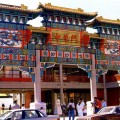Meanwhile the quality of life in Chinatown in general has been enhanced by the redevelopment of Block 17 which includes new quarters for SUCCESS, a 100-bed intermediate care facility and hundreds of units of social and market housing. The presence of a community police storefront and security personnel hired by merchants help make Chinatown a safer place to live and visit. Even the neighborhood's notoriously high taxes started to level off in 1994 and gave merchants some much needed breathing space. In view of all these favorable factors, Chinatown is now charged for another boom and enjoys a rosy vista despite the squeeze from Richmond and its new Chinatown.
Demographic changes in Chinatown were once a significant sign-post in Chinese immigration trends. After 1947 the rate of immigration was bolstered by family reunification and some newcomers moved into the adjacent Strathcona region. In the 1960s Strathcona was targeted for redevelopment and the McLean Park housing project was built under the city urban renewal plan. In response, the Strathcona Property Owners and Tenants Association (SPOTA) was formed to ensure preservation of the character of the neighborhood. Many elderly Chinese prefer to live in a familiar environment and senior housing built by the Chow Lun Association at Keefer and Gore and other projects along Hastings and Main became their home.
Many locally born Chinese who came of age in the 1980s, along with overseas immigrants with a taste for more spacious houses, have chosen to settle in new suburbs in the south and east. This factor coupled with its proximity to the Vancouver International Airport and the United States helped kick off the speedy development of Richmond, a small piece of flat land sitting on the mouth of the Fraser River.
In 1961 there were only 298 ethnic Chinese in Richmond. By 1994 about 25 per cent of its population was ethnic Chinese from Hong Kong, Taiwan, mainland China and the Philippines. They are served by social services centres such as the Caring Place and community groups like the Richmond Chinese Community Society. Chinese specialty food markets, Asian malls, the President Hotel and numerous restaurants offering a broad variety of Chinese cuisines sprawl along No. 3 Road.
Aberdeen Centre, Parker Place, Yaohan and the T shopping mall form the longest stretch of modern Chinese shopping arcades in North America.
It is also said to have attracted the highest concentration of good Chinese cooks in overseas Chinatowns. To accommodate the rapid influx of population, city council plans to encourage high density housing in its town centre area which lies between Blundell and Bridgeport on both sides of No. 3 Road.
The Chinese propensity to stay where their language is spoken started the snowball effect, making Richmond the new Chinatown for the middle class. Traditional festivals are celebrated in Richmond with the same fervor displayed at shows by pop singers flown in fresh from their homeland. Two Chinese language radio stations, CHMB AM 1320 and CJVB AM 1470, and the Ming Pao newspaper have all chosen to set up offices here.
With all this prosperity and rapid ethnic change, however, come problems such as huge ESL (English-as-a-second-language) classes, traffic jams, changes in neighborhood character, pressure on services and higher property prices, to name just a few. Nevertheless, the new dynamic of the city has come from some fundamental changes in the nature of Chinese business which are now dominated by large scale food retailing, professional services, corporate investments and realty. Richmond's outskirts, on the other hand, have been rapidly taken up by manufacturing industries and have become a satellite of the town itself, whereas farmland on Steveston Highway east of No. 4 Road and a five-hectare nursery site right in the downtown core have given way to new residential and commercial developments. Even the fishermen's quay has been quick to respond to the delicate Chinese taste for live seafood. Residentially, Richmond tends to attract many affluent or professional Chinese immigrants.
Within the last two decades the Chinese have helped change Richmond from a sleepy fishermen's village into a city of over 140,000 people. Together with the old Chinatown on the eastside of downtown Vancouver they house about 270,000 Chinese and will surely go down in the history of Canada as models of historical and modern Chinatowns.

